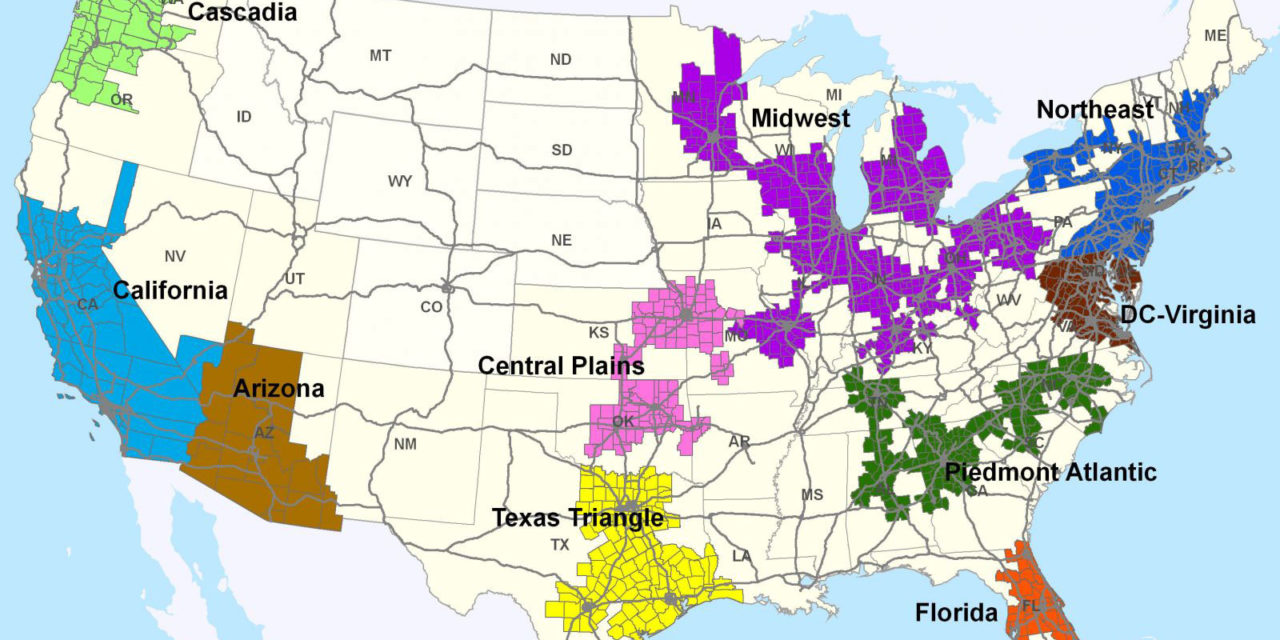Almost 15 years ago, the headline on this blog was “Super Regions Bring Super-sized Challenges for Memphis” and the post was about the way that megaregions were more and more becoming the foundation for growth.
About the same time, questions about the future of cities seem to move megaregions off the front burner. In the Northeast and Midwest, cities were struggling, they were, blighted and they were stagnant to the point that people questioned their actual survival rather than their role in a megaregion power center.
But that did not mean that the idea of megaregions went away. As cities turned around, revitalized, and became economic engines for the country’s economy, some planners reconsidered how megaregions, once called megalopolis, would assume drivers of prosperity for the future.
Today, megaregions are becoming more and more a context for planning, federal funding, and investment.
Getting Aware of Megaregions
Memphis is not part of a megaregion. The closest one is 200 miles away and includes Nashville as part of the Piedmont Atlantic megapolitan. There’s no argument now that predictions 15 years that Nashville’s place in this megaregion positioned it for economic boom, more national prominence, and growth have exceeded even those optimistic expectations.
It would have been useful in these ensuing years if the Memphis region had considered the impact of its isolation and to devise possible ways that it could be connected to the Nashville megaregion. While internal competitions and rivalries threaten the full potential and impact of megaregions, there’s no argument that they are major transportation corridors, or said a different way, major economic corridors.
The importance of considering our place in this megaregions framework was emphasized by the American Planning Association: “The megaregion — networks of metropolitan areas that share economic, environmental, and cultural features, as well as infrastructure and geographic connections — is a powerful, empirically grounded concept for characterizing problems and opportunities that profoundly impact regions and local communities across multiple systems at larger geographic scales.
“The megaregions concept is transitioning from planning theory to planning practice, due in large part to a growing awareness that many systems, from transportation networks to watersheds, extend beyond metropolitan boundaries and can benefit from coordinated approaches to planning.”
APA seemed to be speaking to the Memphis region when it said local and regional planning agencies are aware of megaregions but “relatively few incorporate megaregional issues into their plans.”
It’s been obvious for decades that regions are economic units – even when cities in regions like ours compete against each other for jobs and approve incentives that erode the overall regional tax base.
Ultimately, the question is whether an economic unit like our region can compete against a megaregion economic unit.
Planning for Megaregions
While we haven’t considered our relationship with megaregions and our success, that doesn’t mean other places aren’t doing it.
For example, the Regional Plan Association is pursuing the “American 2050” strategy, which states: “America 2050 is developing a framework for America’s future growth that identifies 10 or more emerging megaregions as the proper scale at which to make the investments that will maximize America’s competitiveness and broaden opportunities for all members of our society.”
“This framework will promote integrated investments in mobility, environment, and economic development that are needed to guide the nation’s growth in the 21st century. It will provide capacity for growth by creating a world-class multimodal transportation system of new smart highways, high-speed rail, airports, and seaports, all of these linked to concentrated developments at central hubs. It will preserve large environmental (or “green infrastructure”) systems, strengthen metropolitan regions and urban centers, and alleviate concentrated poverty by expanding economic opportunities to bypassed areas. The federal role in land use will be reformed to support collaborations across regional boundaries, promote megaregional decision making, and utilize federal funding to ensure consistency with national objectives for growth.”
American 2050’s purpose is “to organize and direct the trillions of dollars of investments that will be made over the next generation in infrastructure, housing and urban development, environment protection, and new energy systems.”
It’s Connectivity, Stupid
It’s an audacious objective but it’s a sign of the emerging importance of megaregions, and the fact remains that because initiatives like this are focused on 10 (some advocates propose 13) megaregions, it means that Memphis is on the outside looking in.
A glimmer of hope is posited by Parag Khanna, author of Connectography, Mapping the Future of Global Civilization, who argues for seven super-super-regions, and in his map, Memphis is in the Piedmont Atlantic that extends west all the way to Little Rock.
His conclusion: connectivity, not geography, is destiny.
It seems a long shot for the U.S. to only have seven megaregions that take up the entire country, but Mr. Khanna sees it as the key way the U.S. can compete with China.
The problem is that we can’t wait to see if he is right. Already, our region’s economy is not keeping pace with regions that used to be our peers.
It means that our region must move beyond its meager efforts at regional talking and thinking. It’s not that we’re not civil and willing to talk, as RegionSmart proves each year, the Mid-South Mayors’ Council proves routinely, and as the $360,000 Governors’ Alliance for Regional Excellence plan proved two decades ago, but the evidence of translating the talk into a firm agenda for action or priorities is hard to find.
The Rich Will Get Richer
There’s never been a better time to assemble our smartest thinkers – planners, economists, businesspeople, academics, and more – to consider how the scenarios for how emergence of megaregions will affect our region and if there a play that Memphis can make to benefit from it.
It is possible that there has never been more planning than is going on today in our region.
In Memphis and some of North Mississippi cities, planners are thoughtfully developing plans for their communities.
Then too, there is Urban Land Institute Memphis, Memphis Area Association of Governments, Memphis Urban Area MPO, West Memphis MPO, University of Memphis City and Regional Planning, BLDG Memphis, RegionSmart, city and county planners, and many more who could collaborate to consider these megaregion issues and to issue a manifesto for our region.
Some commentators have divided responsibilities this way. Cities are to deal with traffic issues; regions handle land use, housing, and economic development, and megaregions manage transportation between metro areas, especially high-speed rail connections that are going to be keys to determining winners and losers for the future.
Of course, we don’t have to do anything. We can simply continue coast into the future, which is likely to be defined as the rich getting richer.
But if we don’t quit coasting, is a sure bet we won’t fall into the richer category.
September 30, 2007 – Super Regions Bring Super-sized Challenges For Memphis
*****
Join us at the Smart City Memphis Facebook page and on Instagram for blog posts, articles, and reports relevant to Memphis.





This is an important conversation and as relevant today as it was 15 years ago. A proactive approach to mega-regions (MR) is important as both an economic driver and as the ultimate organizational level of any group of communities. I would argue that at the organizational and initiative level, some strides have been made in the region to accelerate along this path, specifically RegionSmart and- perhaps more importantly- the Tri-State Compact Initiative.
I would suggest the Memphis region is not separated from Nashville by 200 miles. MR are defined not simply as a function of the separation of their central cities, but also as a function of medium and even smaller communities between. With that in mind the distance between the eastern fringes of Jackson and western most Dickson is a mere 70 miles. Blue Oval will further solidify the interlocking relationships shared by Memphis, Jackson and all the communities between. This also begins to shine a light on the issues that underpin how, why and where MR have evolved that largely involve barriers be they topographic, demographic and/or political.
If MR are to transition away from a somewhat unintentional aligning of economic and geographic stars to intentional places, then local and regional conversations need to be incorporated that include “the in-between” and those that live there. There may not be universal support for the physical change that tends to occur between communities that are intertwined in these tight economic bonds. As an example, the connections between central cities or hub communities within MRs are largely characterized by sprawling development patterns over what may be very productive agricultural land paired with an associated escalation in property values along these corridors and connections that makes stewardship of the existing largely rural nature of these communities all but impossible. Taking a more proactive role may help better mitigate for unintended impacts, but conservative legislatures have proven to be wary or suspect of such land-use regulatory tools. Similarly, should the 7 (or so) counties located within this separation all adopt stances that are staunchly and aggressively anti-change, the full integration of the areas beyond as a single MR may be thwarted. There are also larger, almost philosophic, questions if you happen to be in a city on the edge or between MRs: Does a community have a choice regarding fully integrating within a MR? If so, which MR does a community proactively plan to integrate with going forward? These may appear to be an almost unnecessary, overly rigid application of the concept, but they very quickly translate to where, when, how and in what infrastructure, land-use policies, institutions and locations will investments be made or given a priority.
An optimist would say that the relative lack of change in the places “between” is also the region’s great opportunity. In many of the places that come to mind when the concept of mega-region is mentioned- the Piedmont/Atlantic, the Northeast Corridor, the Texas Triangle- planning at the scale of the mega-region is not the result of pro-active choice, but a realization of necessity due to poorly planned infrastructure, inefficiencies and inequalities in the face of rapid population growth. Rectifying these issues often requires mitigation or the necessity of shoe-horning solutions into an already crowded landscape which costs more in both time and money than would have been required by forethought and planning at the outset. There is opportunity now within this region to proactively consider those issues and goals that naturally lend themselves to a shared approach and model. However, time may be of the essence. Changing economic winds suggest that opportunity may be closing, after which we will increasingly surrender our voice and preferences to chance and the whim of individual and often narrowly focused circumstances.
Thanks for the insightful points into this conversation. Great to hear from you again. I am pleased that you see impact from RegionSmart. I wish there was more action and less talking but perhaps you know of concrete things that have taken place because of it. I sure don’t want to sell it short if it has a track record of results.